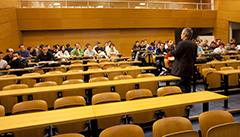
Sciences & Société
Soutenance de thèse : Félix SCHMITT
Interactions rayonnement-atmosphère en milieu urbain : modélisation avancée et analyse de leurs effets sur le rafraîchissement
Doctorant : Félix SCHMITT
Laboratoire INSA : CETHIL
École doctorale : ED162 : MEGA de Lyon (Mécanique, Energétique, Génie civil, Acoustique)
Avec l'urbanisation mondiale croissante et des vagues de chaleur de plus en plus intenses et fréquentes, la surchauffe urbaine a des conséquences délétères sur le confort et la santé des citadins. Prédire les conditions microclimatiques urbaines est dès lors crucial pour comprendre et atténuer cette surchauffe. Ce travail de thèse propose un modèle micro-météorologique avancé, capable de simuler les interactions entre rayonnement infrarouge thermique (IRT) et atmosphère urbaine à micro-échelle. Il s’agit du couplage entre un solveur CFD basé sur la méthode de Boltzmann sur réseau et la simulation des grandes échelles, et un solveur IRT en milieu participant. Le solveur IRT est d’abord appliqué dans une rue canyon dont les parois sont plus chaudes que l'air. Les résultats montrent que le flux IRT moyen absorbé aux parois est surestimé de 4 à 12 W/m2 en considérant l'air comme transparent, pour un rapport d'aspect compris entre 0,75 et 2,4. Des simulations de convection mixte sont ensuite réalisées dans une rue canyon à échelle réduite, dont les parois sont chauffées, démontrant la capacité du solveur à reproduire les caractéristiques moyennes et turbulentes de l'écoulement mixte et des transferts de chaleur, par comparaison des solutions à des mesures en soufflerie. Enfin, des simulations micro-météorologiques couplées IRT- CFD dans une rue canyon à échelle réelle, sous des conditions météorologiques réalistes, sont effectuées afin d’évaluer l’impact des interactions IRT/air sur l’écoulement et le rafraîchissement de la rue après le coucher du soleil. Les résultats indiquent que l'écoulement mixte n’est pas affecté par les interactions. Le refroidissement moyen de surface est 4 à 8 % plus rapide avec les interactions. L'ensemble de ce travail conforte la pertinence d'un niveau de modélisation élevé dans une configuration de rue pour l'étude dynamique des microclimats urbains sous l'influence des interactions IRT/atmosphère.
Additional informations
-
Amphithéâtre Eugène Freyssinet, Bâtiment GCU, INSA Lyon (Villeurbanne)
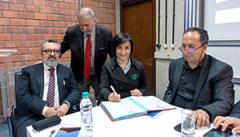
International
L’INSA Lyon lance le projet « FALSAFA » pour promouvoir le développement durable et la responsabilité sociale
Le projet « FALSAFA », dont le nom signifie « philosophie » en arabe, fait référence au courant de pensée développé par les philosophes Ibn Sinā et Ibn Roshd, qui préconisaient que l'homme doit se conformer à la nature plutôt que de chercher à la dominer.
Porté par l’INSA Lyon en partenariat avec l’ambassade de France en Tunisie, ce projet ambitieux, axé sur le Développement Durable et la Responsabilité Sociale s’étendra sur deux ans et s'inscrit dans le cadre de la chaire UNESCO visant à former les ingénieurs aux enjeux socio-écologiques.
Les objectifs du projet :
- Mettre en place des modules d'enseignement sur le Développement Durable (DD) et Responsabilité Sociale (RS).
- Éditer une revue scientifique internationale, à comité de lecture, spécialisée dans les domaines du DDRS.
- Créer un réseau d'établissements (Méditerranéens et Subsahariens) adhérents aux principes fondamentaux des Chaires UNESCO DDRS de l'INSA Lyon et Réseaux du RMEIM.
Pour mener à bien ce projet, cinq écoles d’ingénieurs tunisiennes et 3 autres partenaires français ont été mobilisés :
- l'Institut National des Sciences Appliquées et de Technologie (INSAT),
- l’École Nationale d'Ingénieurs de Monastir (ENIM),
- l’École Nationale d'Ingénieurs de Gabès (ENIG),
- L’École Supérieure des Ingénieurs de Medjez El Bab (ESIM),
- l’École nationale d'ingénieurs de Sfax (ENIS),
- Centrale Méditerranée,
- INSAVALOR,
- Réseau Méditerranéen des Écoles d’Ingénieurs et de Management (RMEIM).
Une délégation composée de Damien Fabrègue, Directeur de la DAREI, Nicolas Freud, Directeur de la transition socio-écologique, Jean-Yves Champagne, Chargé de Relation Afrique et Fatma Saïd-Touhami responsable de la cellule Appui aux Techniques de l’Enseignement, du Numérique et de l’Apprentissage (ATENA) a participé à une mission du 2 au 4 mai 2024. L’objectif était la signature officielle de la convention et la présentation de l’accompagnement pédagogique apporté par l’équipe ATENA aux différents partenaires.
Ce projet s'annonce comme une initiative transfrontalière d'envergure, promettant des avancées significatives dans le domaine du Développement Durable et de la Responsabilité Sociale.
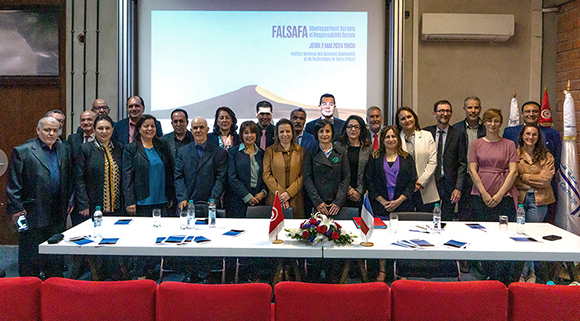
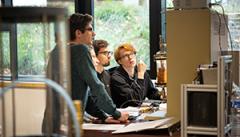
Formation
La formation des ingénieurs INSA aux enjeux socio-écologiques au cœur d’une chaire UNESCO
Engagé depuis 2019 dans un vaste chantier visant à former tous ses élèves-ingénieurs aux enjeux socio-écologiques, l’INSA Lyon se voit reconnu par la création d’une chaire Unesco. Ce label souligne la pertinence et la qualité du travail entrepris par les membres engagés dans le déploiement des nouveaux enseignements. Intitulée « former les ingénieurs aux enjeux de la transition socio-écologique », cette chaire qui réunit une quinzaine de partenaires nationaux et internationaux, a pour vocation d’amplifier les collaborations, partager les bonnes pratiques et approfondir les réflexions.
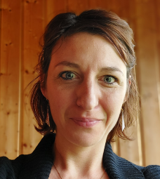 Une chaire dédiée aux actions entreprises pour former les ingénieurs aux enjeux socio-écologiques
Une chaire dédiée aux actions entreprises pour former les ingénieurs aux enjeux socio-écologiques
Le cursus de formation d’ingénieur à l’INSA Lyon effectue progressivement sa mue, avec, à la rentrée dernière, la mise en place de ses premières applications. Pour que tous les élèves-ingénieurs développent une compréhension profonde et systémique des enjeux de durabilité et deviennent acteurs de la transition socio-écologique, plus de deux cents enseignants sont mobilisés pour poursuivre le déploiement de nouveaux enseignements. Le chantier, hors norme, s’étalera sur cinq ans. « L’idée de construire une chaire Unesco s’est imposée à nous assez naturellement », témoignent les deux initiatrices du projet, Laurence Dupont, enseignante en chimie, et Fatma Saïd Touhami, responsable de l’équipe d’appui pédagogique ATENA. « En effet, l’objectif d’une chaire Unesco est de promouvoir un ensemble intégré d’activités de formation et de recherche, d’information et de documentation autour d’une thématique choisie. Il s’agit aussi de contribuer à bâtir des passerelles entre le monde universitaire, la société civile, le monde socio-économique et l’élaboration des politiques. Avec un principe fondateur : l’échange de connaissances et d’expérience, et la collaboration. »
À travers ce label, reconnu dans le monde entier, l’INSA Lyon entend participer à la coopération mondiale pour l’Éducation, les Sciences et la Culture grâce à la force du réseau d’établissements d’enseignement supérieur et instituts de recherche réuni par l’Organisation mondiale. « L’Unesco est une référence mondiale dont les travaux en matière d’éducation sont particulièrement inspirants. Nous avons pensé qu’une chaire Unesco serait un atout considérable pour développer un réseau de partenaires autour de l’enjeu clé de la formation des enseignants. Car pour former des étudiants aux enjeux socio-écologiques, il faut d’abord amener les enseignants à se former », précise Nicolas Freud, chef de projet évolution de la format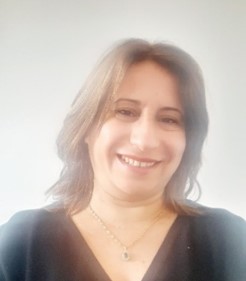 ion depuis 2020 et responsable de la chaire.
ion depuis 2020 et responsable de la chaire.
« Il s’agissait également de nous associer à des partenaires reconnus pour leur expertise en sciences de l’éducation. Nous nous sommes notamment rapprochés du laboratoire ADEF1, de l’Université d’Aix-Marseille, avec lequel nous avons lancé en 2020 la thèse de Hugo Paris sur l’intégration des enjeux socio-écologiques dans la formation des ingénieurs, avec un focus sur les changements que cela implique pour les enseignants », explique Fatma Saïd Touhami.
Un réseau international pour partager ses expériences et s’inspirer des différences
Si l’INSA Lyon pouvait déjà compter sur ses liens avec de très nombreux partenaires académiques internationaux, il n’existait pas jusqu’ici de collaboration spécifiquement dédiée à la formation aux enjeux socio-écologiques. C’est ce que permet désormais la chaire Unesco : un partage des réflexions et des expériences concrètes, avec l’immense plus-value d’une approche interculturelle. « Le plus grand intérêt d’une collaboration internationale, particulièrement avec des pays du Sud, est de pouvoir sortir d’une vision purement occidentale. Nos contextes locaux étant très différents, nous n’avons pas les mêmes préoccupations que nos partenaires tchadiens, tunisiens ou mauritaniens à propos des enjeux du climat, des ressources et de la biodiversité. Nos échanges n’en sont que plus intéressants et enrichissants », explique Valérie Lebey, chargée de projets Afrique à la Direction des Relations Européennes et Internationales. « Nous travaillons actuellement sur un projet intégrant une approche COIL (Collaborative Online International Learning) avec nos partenaires colombiens. Il s’agit d’une collaboration inter-universitaire à la fois entre enseignants, engagés dans une démarche de co-construction des activités pédagogiques, et entre étudiants, invités à suivre simultanément les activités d’apprentissage en ligne. L’objectif est de faire vivre une forme de mobilité virtuelle aux étudiants, en les amenant à s’enrichir mutuellement des approches et des expériences de chacun, sans les impacts associés aux déplacements internationaux », poursuit Laurence Dupont.
Apporter des réponses aux attentes croissantes du monde socio-économique
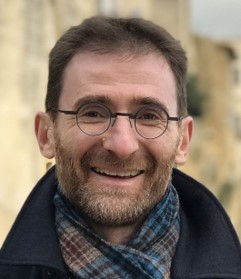 Conduits selon quatre axes de travail, les travaux de la chaire Unesco n’a pas seulement pour ambition de transformer la formation des ingénieurs. Les porteurs de la chaire voient plus loin. « Les entreprises avec lesquelles l’INSA est en relation – via la Fondation INSA Lyon, par exemple – soutiennent les évolutions de la formation engagées par l’établissement. Elles commencent aussi à exprimer des besoins d’accompagnements et de formation de leurs personnels en activité, de leurs cadres dirigeants et de leurs ingénieurs ; les entreprises sont fortement intéressés par les nouveaux enseignements développés à l’INSA. Nous explorons cette question et échangeons notamment avec nos partenaires de l’Université de Sherbrooke, qui ont déjà une expérience en la matière », ajoute Nicolas Freud.
Conduits selon quatre axes de travail, les travaux de la chaire Unesco n’a pas seulement pour ambition de transformer la formation des ingénieurs. Les porteurs de la chaire voient plus loin. « Les entreprises avec lesquelles l’INSA est en relation – via la Fondation INSA Lyon, par exemple – soutiennent les évolutions de la formation engagées par l’établissement. Elles commencent aussi à exprimer des besoins d’accompagnements et de formation de leurs personnels en activité, de leurs cadres dirigeants et de leurs ingénieurs ; les entreprises sont fortement intéressés par les nouveaux enseignements développés à l’INSA. Nous explorons cette question et échangeons notamment avec nos partenaires de l’Université de Sherbrooke, qui ont déjà une expérience en la matière », ajoute Nicolas Freud.
Une chaire au service de la communauté INSA
L’un des enjeux de la chaire est de valoriser les travaux de l’INSA et de susciter de nouvelles collaborations dans le périmètre thématique de la formation des ingénieurs aux enjeux socio-écologiques. La chaire est ouverte à tout enseignant désireux de contribuer à l’un de ses axes.
Pour en savoir plus : https://chaires.insa-lyon.fr/chaire-unesco
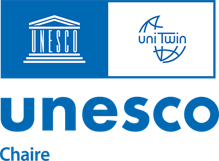 Le programme de chaire Unesco
Le programme de chaire UnescoLancé en 1992, le programme UNITWIN/Chaires Unesco vise à renforcer la coopération au niveau international entre les acteurs académiques. Avec plus de 850 établissements de 117 pays dans le monde, il favorise le partage de connaissances et les coopérations sur les questions prioritaires en lien avec les domaines de compétence de l’Unesco, à savoir l’éducation, les sciences exactes et naturelles, les sciences sociales, la culture et la communication.
Grâce à ce réseau, les établissements d’enseignement supérieur et les instituts de recherche du monde entier mettent en commun leurs ressources, tant humaines que matérielles, pour relever les défis pressants et contribuer au développement de leur société. Ces travaux ont prouvé leur utilité s’agissant d’orienter les décisions politiques, de mettre en place de nouvelles initiatives pédagogiques, de générer de l’innovation par la recherche et de contribuer à l’enrichissement des programmes universitaires existants tout en promouvant la diversité culturelle.
[1] Laboratoire "Apprentissage, Didactique, Evaluation, Formation"

INSA Lyon
Former les ingénieur(e)s humanistes de demain : webinaire sur les évolutions à l’INSA Lyon
L’INSA Lyon est engagé depuis 2015 dans une série de démarches visant à actualiser sa mission de formation, en réponse aux défis socio-écologiques, voire anthropologiques de notre temps.
Les réflexions menées ont conduit à l’adoption d’une nouvelle politique de formation en Humanités, au déploiement du chantier d’évolution de la formation sur les cinq ans à venir et à la participation au projet ClimatSup, né de la collaboration entre le Groupe INSA et le think-tank The Shift Project.
Ce webinaire sera l'occasion de faire un point d’étape sur la réforme et les modifications en cours du profil de l’ingénieur humaniste INSA. Quelles sont ses nouvelles facettes ? À l’exercice de quelles responsabilités les ingénieurs de demain seront-ils formés et comment ? Quel est, aujourd’hui, le rôle des Sciences Humaines et Sociales dans une école d'ingénieurs qui revendique un modèle humaniste de formation ?
Alumni, vous vous demandez comment la formation INSA a évolué depuis votre diplôme ? Vous souhaitez contribuer aux transformations en cours en partageant votre expérience de terrain ? Venez vous informer et échanger avec Nicolas Freud, Chef de projet « Évolution de la formation », et Carine Goutaland, Directrice du Centre des Humanités.
Inscription en ligne => https://www.alumni-insa-lyon.org/agenda/2415/identification
Additional informations
-
En ligne
Keywords (tags)
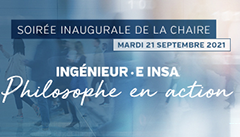
Institutionnel
Conférence inaugurale de la Chaire Alumni / INSA Lyon
« Ingénieur INSA, philosophe en action. Penser et agir de manière responsable »
À l’heure où la crise environnementale requiert un changement sans précédent de nos modèles de développement et de nos modes de vie, la chaire Alumni / INSA Lyon convie la communauté insalienne à un temps de réflexion sur la responsabilité de l’ingénieur.e dans la transition écologique.
Quels sont les défis auxquels les ingénieur.e.s de demain devront faire face ?
Quel sera leur rôle dans une société et un système Terre profondément marqués par une technique dominatrice de la nature et par le mythe, aujourd’hui ébranlé, d’une croissance illimitée ?
Quels savoir-être et quelles compétences leur permettront de devenir des acteurs responsables de la transition ?
Par la participation exceptionnelle du philosophe Dominique Bourg et un temps d’échange rythmé par une table ronde, nous nous demanderons vers quels types de société « transiter » et comment l’ingénieur.e pourrait participer activement à la transition écologique.
Additional informations
- https://communication.insa-lyon.fr/20210921_chaire-alumni/
-
En présentiel à la Rotonde - 20 avenue des arts - Villeurbanne et en distanciel
Keywords (tags)
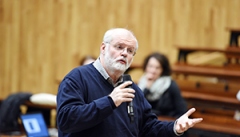
INSA Lyon
INSA engineer, philosopher in action
The role of engineers and their future are at the heart of a process of reflection being undertaken at INSA Lyon with its entire ecosystem. Scientific Co-Director of the Chair ‘Ingénieur.e INSA, philosophe en action. Penser et agir de manière responsable (Thinking and acting responsibly)’, Michel Faucheux, former director of the Humanities Centre at INSA Lyon, a man of letters, sheds light on the context in which this research work is emerging, useful for engineers and the world of tomorrow.
The creation of the chair ‘Ingénieur.e INSA, philosophe en action. Penser et agir de manière responsable’ is in line with the legacy of the philosopher Gaston Berger, one of the founders of INSA Lyon. Although the educational project of training an engineer1 in direct contact with society and its technological, social and economic issues remains relevant, the fact remains that times have changed and we are no longer in the ‘Trente Glorieuses’.
The Chair aims to update and rethink the INSA engineering model while remaining faithful to a heritage that gives our school a strong historical, philosophical and educational identity, which is what makes it unique in the field of French engineering schools. In a conference speech on 8 March, 1955, Gaston Berger described company directors as ‘philosophers in action’, ‘having become aware not only of the complexity of problems, but also of the duties that are imposed on them and that give them an ethical role’. More than ever, to meet the unprecedented challenges facing us, engineers, engaged in technical ‘businesses’ and often company directors themselves, must assume the role of ‘philosophers in action’, guided by a love of a combination of (technical) knowledge and wisdom to guide their actions and make them capable of rebuilding a more humane world.
For the task before us is a huge one, quite different from that of engineers educated in the 1960s, the driving force behind economic growth and well-being that benefited a France shaken and impoverished by the war years.
Two decades ago, we entered a new world produced by an accelerated and radical technological revolution, which some call ‘disruption’. This artificial, digitised, interconnected, virtualised, globalised, multicultural world is shaking up the relationship of human beings with themselves as well as with society, nature and other living beings. The old oppositions that anchored us in a stable relationship with the world have been shattered: true and the false, real and virtual/artificial, man and machine, me and others, here and elsewhere, inside and outside... While our opportunities for action have increased tenfold.
If ‘the world before’ was stable, solid, based on a foundation of guaranteed practices, certainties and representations, this new world where one can surf for all kinds of knowledge and where information circulates at full speed is a ‘fluid’ world, fluctuating, tempestuous, characterised by turmoil, disorder, crisis and the unexpected.
This is what we are currently experiencing: a pandemic that has immobilised a large part of the planet and is linked to a major ecological crisis which, caused by the accelerated destruction of species and global warming, is endangering humanity. The phenomenon of crisis is no longer occasional. It has become structural, the constituent element of our world, taking on several interrelated dimensions: ecological, social, societal, economic and political.
In this new context, the aim of the Chair is to help educate engineers, ‘philosophers in action’, who are not only able to deal with crises and storms but creative and ingenious, cutting across different areas of knowledge to think about technology at a time when the knowledge map is changing. This will also lead us to our destination: a diverse, viable and sustainable world order that engineers will have helped to build. This is not a mere utopia, for there is an urgent need to move towards an economic and social system that recognises the finiteness of the earth's resources and puts technology, freed from the dreams of all power and unlimited profit, at the service of humanity, building a new alliance between human beings and nature but also solidarity between human beings, cultures and societies. Finally, it integrates aesthetic concerns into everyday life.
There has never been such a challenge in the history of mankind because, for the first time, we are talking about the survival of our species and the viability of human constructions. At the end of this long period of lockdown, ‘the time has come’, as many now say, to rebuild a future. There have been builders of monuments of all kinds and major political and social projects... There is now a need for builders of the future. And we believe that ‘the INSA engineer, philosopher in action’, to be faithful to his or her history, must be one of those builders of the future, made up of a mix of technology and wisdom, built on resistance to injustice, inequality and the unacceptable.
But the future cannot be built without the experience of those already engaged in action. This is why the Chair, which is open to the INSA community from which it emanates, thanks to a co-construction approach, will draw on the practical experience of alumni to analyse how we can deploy a responsible mode of action in the company and society, and develop everyday ethics and ‘wisdom’ of action beneficial to all. It will be based on the strength of testimony, feedback and analysis of debates generated by, for example, decision, action and implementation.
The only great projects are those driven by a shared memory and vision. But there are also moments when the storm that sweeps away history can metamorphose into a breath of fresh air towards the future. Caught between a major technological revolution and a radical ecological crisis, we are living at a time that requires us not to look away from ‘our burning house’ but to resist and fight the destructive approaches that threaten the construction of a sustainable world.
We should not be afraid of ambitious projects. The creation of the INSA alternative model was itself an ambitious project. This is why, in the end, I wonder if the project of this Chair is limited to supporting the education of an ‘engineer, philosopher in action’, a bearer of humanist and responsible values - which is already a lot! Perhaps it is much more than that: to help, at the beginning of the 21st century, with the reinvention of humanism, of which INSA engineers should be among the initiators.
In the 16th century, aided by the technical invention of printing, poets, philosophers and scholars returning to the texts of Greek and Latin Antiquity invented a ‘Humanism’ that presided over the period later described as the ‘Renaissance’. INSA engineers, who have become ‘philosophers in action', combining knowledge, thinking about technology to better work with ‘wisdom’ and defining, in an artificial universe, an ideal of human behaviour, could contribute to the reinvention of a humanism that has become our horizon and our necessity. Do we even need to add that there are places conducive to such reinvention and that in the 16th century, Lyon was one of the great centres of Humanism?
Gaston Berger, in the conference speech already quoted, noted that company directors, ‘philosophers in action’, ‘do not simply shape objects’, but ‘build the destiny of men’. In exactly this way, I believe that the INSA engineer of today and tomorrow, the ‘philosopher in action’, must play the role not only of offering a destiny to ‘men’ but of working to ensure that they continue to have one.
The task is difficult and exhilarating, but if the Chair ‘Ingéieur.e INSA, philosophe en action. Penser et agir de manière responsable’, in its rightful place, can help, then it will have found its greatest purpose.
The scientific committee of the chair
It is made up of members from the Gaston Berger Centre, the Humanities Centre and the INSA Lyon Alumni Association.
▪️ Francesca Rebasti, Research Fellow, Coordinator and Scientific Co-Director of the Chair. A Doctor of Philosophy, she specialises in the history of moral and political doctrines.
▪️ Michel Faucheux, Scientific Co-Director of the Chair. A Doctor of Letters, historian of ideas, lecturer, researcher and writer, he co-directed a doctoral thesis on the role accorded by Gaston Berger to the humanities in the education of engineers.
▪️ Marie-Pierre Escudié, Scientific Co-Director of the Chair, is a lecturer and researcher at the Humanities Centre and the Gaston Berger Centre at INSA Lyon, and works on the topic of the social responsibility of engineers.
▪️ Patrice Heyde, Vice-President of the INSA Lyon Alumni Association, Co-Facilitator of the Chair.
▪️ Sonia Béchet, Deputy Director of the Gaston Berger Centre at INSA Lyon, has a doctorate in cognitive psychology.
▪️ Carole Plossu, Director of the Gaston Berger Centre since its creation in September 2015.
▪️ Nicolas Freud, Director of the Humanities Centre, in charge of steering the INSA Lyon education development project.
▪️ Carine Goutaland, Deputy Director of the Humanities Centre, in charge of humanities and social sciences.

INSA Lyon
Alumni Chair/INSA Lyon: INSA engineer, philosopher in action
With the Chair ‘Ingénieur INSA, philosophe en action. Penser et agir de manière responsable (Thinking and acting responsibly)’, INSA Lyon and its Alumni Association, the INSA Lyon Foundation and the commercialisation subsidiary INSAVALOR aim to question the role of the engineer and provide food for thought on how it is changing in a society transformed by key issues.
Climate emergency, ‘robolution’, crisis of representation and practice... Today's world is undergoing profound upheavals and is beginning to detect the obstacles in our socio-economic systems. The issues currently facing us are huge and in order to deal with them, the world must reinvent itself.
Engineers are at the crossroads of this new world and its challenges. Humanist as the founders of INSA Lyon wished, INSA engineers had to bear the societal responsibility of their actions but also of their ideas. This representation, which was developed at the end of the 1960s when the INSA model was created, has not aged, but resonates very strongly against a background of major changes.
How is this ‘engineer, philosopher in action’ changing in our society today? What wisdom can he develop in the face of current challenges, an uncontrolled and uncontrollable digital revolution, an uncertain and unforeseen future? What values will he be able to refer to and what ideal will he seek to convey in a world where humanity is struggling to look ahead? How will he manage to combine thoughts and actions, expectations and satisfactions, economic needs and vital necessities?
It is in an attempt to answer these questions, and to give full meaning to the humanism of the INSA engineer at a time of upheaval, that INSA Lyon and the INSA Lyon Alumni Association are launching the Chair ‘Ingénieur INSA, philosophe en action. Penser et agir de manière responsable’. Because the world is changing, you have to anticipate this and get moving.
To contribute to the development of this Chair, a participatory financing operation was created on 22 June 2020: https://crowdfunding.groupe-insa.fr/fr/projects/chaire-alumni-insa-lyon
Find out more about the Chair: https://chaires.insa-lyon.fr/chaire-institutionnelle-alumni-insa-lyon
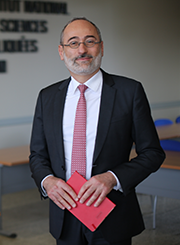
Thinking about the changing role and responsibility of engineers with our alumni
By Frédéric Fotiadu, Director of INSA Lyon
For the past two years, INSA Lyon has been engaged in a forward-looking approach, inspired by the method developed by its founding father Gaston Berger. This work has enabled us to give careful thought to the possible future of our institution up to 2040 by envisaging various scenarios, some of which are disruptive. The Covid-19 crisis brutally confronted us with these exceptional scenarios, which at the beginning of 2020 were still considered unlikely. Faced with the issues resulting from these circumstances, the question of the role of engineers, already at the heart of our forward-looking approach, remains more topical than ever.
Through the diversity of the positions they occupy in all fields and business sectors, through the infinite wealth of their career paths and personal experiences, INSA graduates are both an extraordinary source of information and inspiration, and a great sounding board for these issues. They are also, by their number, a powerful lever for the transformation of companies and organisations in our societies. I am therefore particularly happy and enthusiastic at the idea of this INSA Lyon Alumni Chair to broaden our thinking on the place and responsibility of the engineer in today's world and in the future.
This absolutely exciting project will help to strengthen the links and interactions between our institution and its alumni network. It is also a great opportunity to bring our community closer to graduates who had moved away from it. In a world in search of meaning and new points of reference, this Chair is an invitation to get us all involved in thinking about our role in society on the basis of what has been the very essence of INSA Lyon since its creation: the model of the humanist engineer.
This ‘INSA trademark’ is based precisely on the ability to open up to other disciplines, particularly the humanities and social sciences, in order to grasp the plurality of the world and always question the societal and environmental impact of technologies. It is also about opening up to the world of arts, culture and sport, to develop our thinking and experience of other forms of sensitivity, interactions, practices, other quests for performance and excelling ourselves. Finally, it is a real citizen commitment to social openness and all forms of diversity in order to build a fairer, more inclusive, caring and altruistic world.
Educated according to this model carried forward by INSA and driven by its fundamental values, our graduates are particularly able to detect the multitude of strong or weak signals that herald the changes to come. They have the ability to consider them not only from a technological point of view, but also and above all from a comprehensive intellectual approach. It is precisely this dynamic that will be implemented within the Alumni Chair, at the service of our students, our lecturers and researchers, our partners and society in general.
It will be a question of always preparing ourselves better to face this uncertain, complex future, turned upside down by the present, by adopting a systemic vision to consciously and ethically engage in the major energy, environmental and ecological, digital, but also social and societal transitions, which will allow a desirable future to emerge.
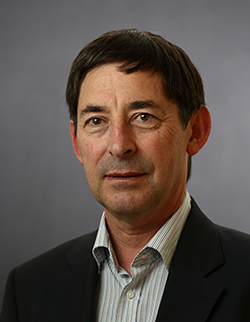 Repositioning the role of the engineer in society
Repositioning the role of the engineer in society
By Daniel Louis-André, INSA electrical engineering class of 1977 and president of the INSA Lyon Alumni Association
INSA engineers, male or female, are attached, maybe now more than ever, to all the values conveyed by the INSA model. Although their features, such as their frame of mind, have not been eroded by time, I think we can see that INSA engineers have changed a lot.
First of all, with the international dimension they have been able to gain, both in business and in wider society. Forty years ago, going on an exchange during your studies was the privilege of a few of us. Since then, mobility has become compulsory for all students and means of communication have developed considerably, making internationalisation much easier to manage.
In this world where everything has accelerated, we also see that INSA engineers are increasingly looking for meaning. Commitment, consistency with the company's values and the usefulness of the job are the driving forces in the search for employment, as well as in keeping a job. Salary is no longer enough for happiness. The model of society of recent decades is no longer dreamt of; it is even criticised. Society has to transform itself.
In my speciality, electrical engineering, engineers are aware that they are right at the heart of the transformation of the energy model. In this race towards low-emission mobility, young people are aware of a key issue: their impact on changing lifestyles to reduce energy consumption.
The environmental aspect and the place of human beings have become paramount.
In the projection of the industry of the future, from factory 4.0, amid big data, connected objects and ultra-technology, there is this path towards innovation at home, short supply chains and customised models.
Engineers will therefore be asked to be ever more creative, in a more comprehensive way. They will be asked to strike a balance between the expertise they will be able to develop with regard to cutting-edge technologies, and the need to work within a wider approach to better integrate the environmental aspect throughout the production cycle and place human beings at the heart of the processes, where they belong.
Engineers of tomorrow must play this role, have this global vision, develop this systemic approach and exercise their critical faculties more than ever. They must be able to look beyond their ‘heritage’ of skills even if it means questioning approaches that seem obvious.
Finally, I personally would like engineers to have a more important role in the city through their general knowledge and know-how, whereas today they have little impact. This is perhaps what we need to pass on to our young people: to learn not to be passive in the face of systems that lock them up in models. The role of the engineer needs to be repositioned, and my optimism leads me to believe that this is possible.
But to succeed in developing new approaches that respond both to engineers’ search for meaning and to the need to reposition their role in society, we must ask ourselves questions about the execution.
How should INSA engineers behave within the company in order to play their role? How will these engineers of tomorrow manage to play an important role in their company while casting their critical eye? How will they be able to initiate change without being seen as the ones who want to revolutionise everything? The concepts of interpersonal skills and understanding of the business world are fundamental here and must guide students’ education, beyond the scientific bases that must naturally be preserved.
I have been President of the Alumni Association since March 2019 and since then, I have been in regular contact with INSA students and graduates. With this Chair, we wish to provide answers to their concerns, particularly with regard to societal and environmental issues. And we can do it together, with the school and the INSA Lyon Foundation.
For me, this tripartite dimension is essential to the success of this project, as of many others. As alumni, we can make the link between those who think about education at INSA Lyon, working engineers and those in the making.
We wish to make this Chair a place for the exchange of ideas and experiences, which produces tangible results for all stakeholders: Schools and lecturers, working engineers and companies.
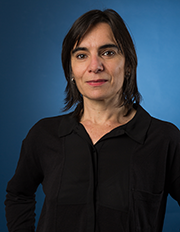 Promoting the model of the humanist engineer
Promoting the model of the humanist engineer
By Laure Corriga, Chair of the Board of INSAVALOR
We support this original Chair, which is perfectly legitimate because it sticks to the DNA of INSA Lyon. Questioning the role of the engineer is part of the school's foundations and it is important to share this reflection with our ecosystem, alongside the Alumni Association and the INSA Lyon Foundation.
For me, engineers are people who, faced with a variety of issues and problems, provide technical and organisational solutions while being aware of the impacts and stakeholders that surround them. Their great quality is their adaptability. Today, in a context where economic, societal and environmental issues are more visible, engineers are becoming players whose role should be greater, with a more prominent place in society. Their vision should be essential, driven by this project approach that they mastered through their education.
The role of the engineer is changing because society is changing. In a world that is becoming more automated, engineers will be forced to change, to take new parameters into consideration. Beyond technological innovation, they will have to measure the impact of their decisions on the societal and environmental levels and, further on, invent new models, in particular by calling on their creativity. They will have to live with change but also initiate it. They will change in a more internationalised context, with collaborations for less immediate responses.
INSA introduces its students to this aim, and wishes to provide them with the necessary knowledge and skills. From this Chair, I would like to see a sort of certification for humanist engineers, which would allow us to bear witness to the INSA career path and the comprehensive approach acquired through education.
INSAVALOR can, on a very operational level, contribute to the work of the Chair on aspects of continuing education and develop educational modules consistent with the philosophical approach taken by this Chair. Moreover, as a player in the field, we will be able to hear the expectations of companies and witness their changes. Some of them have already undertaken a fundamental rethink and have understood that they must flourish with new, more committed generations. Others are working on their employer brand and are moving in this direction.
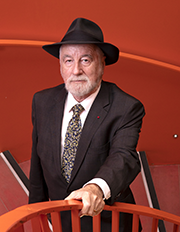
Strengthening the link between different generations of engineers by placing the very philosophy of the profession at the heart of discussions
Jean Guénard, 8th INSA civil engineering class and President of the INSA Lyon Foundation The engineer’s environment has changed since INSA was founded in 1957. For its co-founder, Gaston Berger, man was then at the centre of all concerns. Today, more than sixty years later, we can see that students defend another position: the Earth is now at the centre of their concerns. This concept of ‘Earth in danger’, which was reserved only for a few slightly marginalised elites at the time, has become omnipresent today. The concepts of frugality, repairs and savings have returned to the fore and humanist engineers have this awareness that the earth's resources are not inexhaustible. Engineers, who must henceforth think not only of themselves, must make their contribution to social, economic, intellectual and cultural change in the world around them, and in the organisation of work.
I therefore await from this Chair, with great interest, a practical and current redefinition of the concept of the humanist engineer, where we refer to man but also to the Earth. But for me, engineers of tomorrow are not, apart from this environmental aspect, so different from what they were yesterday. With excellent technique and cutting-edge expertise in their speciality, they have a solid education and an openness beyond their field of expertise, coupled with a general culture that must be as broad as possible.
For me, engineers are people who are interested in what is happening around them, and who put their skills at the service of their values. These are values with which they agree from the time of their education at INSA. These strong values were conveyed by the school when I was a student myself. I am one of those who have had access to this excellent education, even though I am far from the world of higher education. My parents, who were farmers and then grocers in Le Creusot, supported me in my schooling, which was rather satisfactory. Thanks to them, I was able to go to INSA and then benefit from a scholarship in my second year. At the time, I didn't know that I would succeed in the extraordinary feat of ending up in a career rich in dozens of works of art, civil engineering, undergrounds, railways and roads, ports and maritime works and the construction of a unique structure: the Millau Viaduct. Luck? Intuition? Audacity? Ambition? No doubt a bit of all four, but above all a taste and a developed practice of team motivation.
Alone, I am nothing. Together, everything, absolutely everything, is possible
I started out as a works manager and worked my way up through the ranks at EMCC and then Eiffage, until I became President of the Infrastructure division. In my speciality, civil engineering, we design, we build, and we can monitor the implementation. This is a field where we can look to the future. Today, the need for new infrastructure is no longer as strong, and the time has come to renew the heritage and carry out preventive maintenance on buildings. It's a real challenge for engineers in my speciality to deal with what already exists. Thanks to this Chair, driven by the alumni, the link between different generations of engineers will be strengthened, by placing the very philosophy of the profession at the heart of discussions. And, again, I hope to make the unthinkable possible.
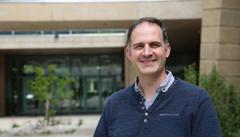
Entreprises
Chaire SKF-INSA Lyon : une histoire qui roule
Un hélicoptère survole le désert du Sahara : ses pales en rotation dessinent un cercle parfait dans l’air. Le frottement des surfaces en contact est consenti par une pellicule de graisse qui se déplace au gré de la rotation, participant à l'équilibre du mouvement du mécanisme. Que se passe-t-il si un grain de sable vient contrarier cette harmonie ? Combien de temps le roulement pourra-t-il fonctionner si le lubrifiant ne parvient plus jusqu’aux contacts, sans entraîner des problématiques de sécurité ? Les interfaces lubrifiées, c’est le cœur des recherches menées dans le cadre d’un partenariat de longue date entre l’industriel SKF et l’INSA Lyon. À l’occasion de la signature du renouvellement de la chaire en mars 2019, rencontre avec Nicolas Fillot qui succède à Philippe Vergne, nouveau pilote côté INSA de la chaire « Lubricated Interfaces for the future ». Interview.
Comment l’histoire entre SKF et l’INSA Lyon a débuté ?
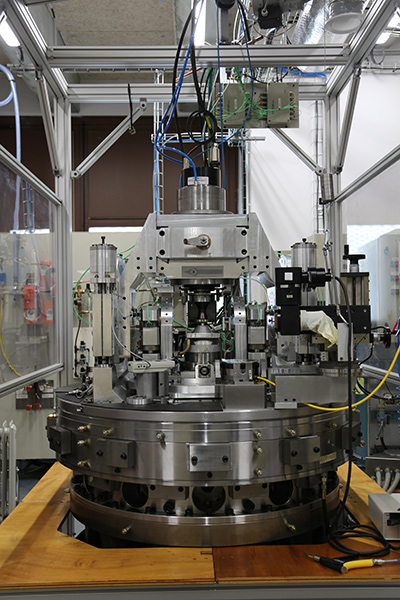 « Les relations entre SKF et l’INSA Lyon sont plutôt anciennes. En 2005 était recruté au LaMCoS1 le premier doctorant qui a travaillé sur la machine Tribogyr, un tribomètre unique au monde pour étudier le contact collet-rouleau des roulements, intégralement financé par le groupe SKF. Ce partenariat s’est trouvé renforcé par l’accueil régulier de Guillermo Morales-Espejel, senior scientist au centre de recherche de SKF au Pays-Bas et chair professor à l’INSA. En 2013, cette relation exceptionnelle s’est officialisée et la chaire « Lubricated Interfaces for the future » est née, permettant aux équipes de continuer à développer la plateforme Tribogyr tout en impulsant de nouveaux projets. Six ans après, le bilan est très positif. Une véritable relation de confiance s’est instaurée et l’énergie est bonne : nous avons renouvelé la chaire SKF-INSA Lyon pour six années supplémentaires ! »
« Les relations entre SKF et l’INSA Lyon sont plutôt anciennes. En 2005 était recruté au LaMCoS1 le premier doctorant qui a travaillé sur la machine Tribogyr, un tribomètre unique au monde pour étudier le contact collet-rouleau des roulements, intégralement financé par le groupe SKF. Ce partenariat s’est trouvé renforcé par l’accueil régulier de Guillermo Morales-Espejel, senior scientist au centre de recherche de SKF au Pays-Bas et chair professor à l’INSA. En 2013, cette relation exceptionnelle s’est officialisée et la chaire « Lubricated Interfaces for the future » est née, permettant aux équipes de continuer à développer la plateforme Tribogyr tout en impulsant de nouveaux projets. Six ans après, le bilan est très positif. Une véritable relation de confiance s’est instaurée et l’énergie est bonne : nous avons renouvelé la chaire SKF-INSA Lyon pour six années supplémentaires ! »
Quel intérêt pour un laboratoire en mécanique de travailler avec un partenaire industriel ?
« Cette organisation synergique permet au laboratoire de développer des thématiques scientifiques sur le long terme. En tentant de répondre aux problématiques de terrain qui émanent de notre partenaire industriel, nous sommes dans le même temps confrontés à des problématiques de recherches fondamentales originales. C’est un double enjeu pour les chercheurs du LaMCos : relever des défis scientifiques autour de la tribologie, tout en résolvant des problèmes technologiques, environnementaux et économiques. »
Vous connaissez bien la chaire SKF pour en suivre les travaux depuis le commencement. Quel avenir souhaitez-vous lui donner ?
« En matière de formation, les échanges avec les élèves du cycle ingénieur de l’INSA Lyon sont constants, notamment grâce au parrainage de certaines promotions. Pour le volet recherche, la plupart des projets que nous prévoyons concerne le fonctionnement des contacts lubrifiés dans des conditions non-idéales : c’est l’exemple du défaut d’alimentation en lubrifiant, ou encore le fait d’utiliser de plus en plus les fluides environnants le contact (carburant, réfrigérant, eau...) à la place ou en combinaison avec les lubrifiants classiques (huile, graisse) qui aura pour conséquence de faire fonctionner le contact dans des conditions critiques. Notre équipe souhaite continuer son développement d’outils expérimentaux et numériques jusqu’à l’échelle moléculaire pour analyser le comportement des interfaces lubrifiées. En modélisant la réponse du lubrifiant dans des conditions sévères et en l’intégrant à des simulations numériques à plus grande échelle, notre objectif est de prédire les performances du contact et ainsi de mieux appréhender la durée de vie des composants et les pertes énergétiques. »
1 INSA Lyon/CNRS/Université de Lyon
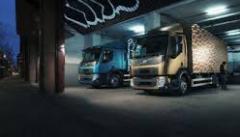
Recherche
Le Groupe VOLVO et l’INSA LYON continueront à penser ensemble le transport urbain de demain
Inventer le véhicule qui assurera la livraison du futur, en anticipant les règlementations environnementales, les évolutions technologiques, la transformation des espaces urbains et les habitudes de ses usagers : voici les enjeux du transport urbain de demain auxquels répondent les travaux inscrits dans la Chaire de recherche VOLVO-INSA Lyon depuis 2014. À travers cette thématique pluridisciplinaire et porteuse d’avenir, les deux acteurs ont établi une relation de confiance qu’ils ont souhaité pérenniser à travers le renouvellement de la Chaire « Solutions for the future of Road Freight Transport » le 15 février dernier.
Transporter des marchandises ou des personnes dans un environnement urbain en constante évolution amène les fabricants de matériel roulant à envisager des solutions durables et intelligentes. Le Groupe VOLVO et l’INSA Lyon travaillent depuis cinq ans autour d’une réflexion croisée sur ces thématiques.
Le Professeur Didier Remond, titulaire de la Chaire explique : « les activités de recherche portent sur des thématiques de développement énergétique durable, la conception et la fabrication de solutions innovantes et du traitement de données. Cela va du design du véhicule, à l’alimentation en énergie nouvelle, en passant par l’utilisation des données récoltées par les transports connectés. Répondre aux enjeux du transport urbain du futur implique de tirer parti des évolutions technologiques, des règlementations à venir et prendre en compte la diversification des usages ou l’amélioration des performances. »
Durant ces cinq années de travaux en synergie avec la recherche et la formation, deux thèses et deux projets post-doctoraux ont démarré. Les travaux ont été concrétisés par la mise en œuvre d’essais sur les plateformes de l’INSA Lyon ou des interactions avec d'autres équipes universitaires. Afin de positionner les acteurs du monde académique et les experts du groupe industriel dans une perspective croisée et interactive, cinq ateliers thématiques ont été organisés sur un mode de « design thinking » et signent les prémices des travaux scientifiques des années à venir.
Portée par la Fondation INSA Lyon, dont le Groupe VOLVO est l’un des Fondateurs, la Chaire s’est aujourd’hui installée dans l’écosystème comme un acteur de référence, émetteur de nouvelles tendances dans le domaine, et est à l’origine de contrats de recherche complémentaires, via la filiale de valorisation de la recherche de l’INSA Lyon, INSAVALOR.
« Le renouvellement de ce partenariat résulte d’une relation de confiance construite ces dernières années. À travers cet échange mutuel, l’INSA Lyon accompagne la vision stratégique du Groupe VOLVO tout en s’inscrivant pleinement au sein de l’enjeu ‘Transports : Structures, Infrastructures et Mobilités’, dans le cadre d’une politique sociétale d’établissement responsable. Nous avons la chance de pouvoir travailler sur des temps longs et faire bénéficier nos étudiants de ces relations partenariales, via le challenge INVOLVE notamment, qui invite 40 étudiants à imaginer des transports urbains innovants », ajoute le titulaire de la Chaire.
L’INSA Lyon fait partie d’un réseau de partenaires privilégiés du Groupe VOLVO, « l’Academic Partner Program » portant sur le recrutement de talents, recherche et formation, à travers lequel le constructeur industriel, mécène et fondateur de la Fondation de l’INSA Lyon, reconnaît l’excellence de l’établissement dans des domaines correspondant à la stratégie et la vision du groupe. « La collaboration avec l'enseignement supérieur est essentielle pour que le Groupe Volvo reste à la pointe de l'innovation dans les solutions de transport. Le partenariat avec l'INSA Lyon est important pour nos activités de recherche sur les solutions de transport urbain en France. Nous sommes heureux de le renforcer avec la création d'une Chaire dont nous attendons beaucoup sur des sujets tels que l'efficacité énergétique des véhicules - notamment à travers l'électrification - l'automatisation, l'industrialisation innovante et dans d'autres domaines-clés », affirme Törbjörn Hollström, Président de la Technologie et de la division Ingénierie Truck du Groupe VOLVO.
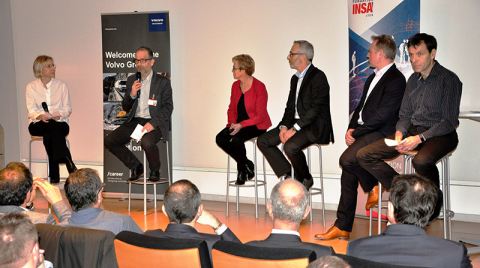
Signature du renouvellement, le vendredi 15 février 2019
Additional informations
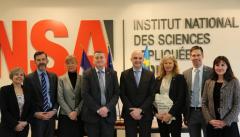
International
Visite de Chalmers University, partenaire historique et pluridisciplinaire de l’INSA Lyon
Le 9 janvier dernier, l’INSA Lyon a accueilli une délégation de haut-rang de Chalmers University of Technology (Suède), composée du Président et quatre Vice-Présidents, dont le VP Recherche et la VP Formation de l’université.
Du coté de l’INSA, le comité d’accueil était composé du Directeur Eric Maurincomme, des directeurs de la Formation, de la Recherche et de ses cinq adjoints, de la Directrice des Relations Internationales ainsi que les porteurs des chaires industrielles, créées toutes deux en 2014, avec les entreprises suédoises SKF et Volvo.
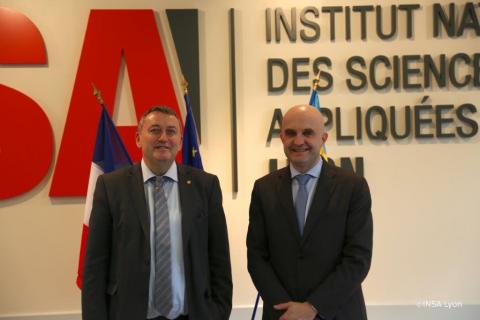
Les discussions engagées ont permis d’identifier des leviers pour les projets de Recherche et pour attirer plus d’étudiants de Chalmers à l’INSA Lyon. Une des pistes concerne le développement de projets de recherche de quelques mois co-encadrés entre nos deux établissements avec des échanges d’étudiants lors de stages. L’offre de cours en anglais de l’INSA, étoffée depuis la rentrée 2018 et étendue à tous les départements pour la rentrée 2019, a notamment été présentée. Favoriser les mobilités administratives et enseignantes entre les deux établissements a également été pointé comme perspective. L’accueil de la délégation s’est terminé par une visite des laboratoires LaMCOS et MATEIS.
C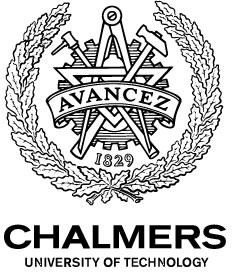 halmers et l’INSA Lyon ont un partenariat renforcé de longue date, le premier accord de coopération ayant été signé il y a 25 ans. Chaque année, en moyenne dix-huit étudiants INSA partent à Chalmers dans le cadre de Erasmus+ et quatre de Chalmers, pour la plupart via le programme UNITECH, sont accueillis à l’INSA Lyon.
halmers et l’INSA Lyon ont un partenariat renforcé de longue date, le premier accord de coopération ayant été signé il y a 25 ans. Chaque année, en moyenne dix-huit étudiants INSA partent à Chalmers dans le cadre de Erasmus+ et quatre de Chalmers, pour la plupart via le programme UNITECH, sont accueillis à l’INSA Lyon.
Les deux universités sont membres du consortium UNITECH, avec sept autres universités européennes d’excellence, mais aussi de CESAER, un réseau européen d’universités leaders dans les sciences et les technologies.

